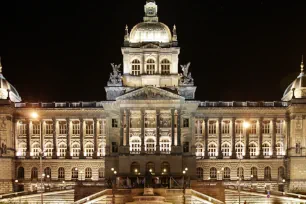The National Museum – a monumental building in Neo-Renaissance style – was built in the late 1880s at a prominent location on Wenceslas Square.

The National Museum was built between 1885 and 1890 by local architect Jozef Schultz, who was also responsible for the reconstruction of the burned-down National Theatre.
The new structure was not only built to house the collection of the museum – founded in 1818 – but it was also built as a symbol of national identity. It was no coincidence that the Neo-Renaissance building was erected at the top of Wenceslas Square. Thanks to its notable location, the National Museum is one of the most photographed buildings in Prague.
The Building

While the building’s exterior is mostly notable for its monumental volume, the interior is the most attractive part of the museum, especially the large staircase hall and the impressive pantheon. The latter hall is dedicated to leading figures of the Czech nation. The vaults are richly decorated with ornaments and frescoes, and the hall is topped by a magnificent glass dome.
Exhibitions
Besides temporary exhibitions, the museum has permanent exhibitions on biology, anthropology, mineralogy, geology, decorations and numismatics as well as an exhibition about the history of the region.
Renovation and Expansion

In 2015 a major renovation of the national museum building started that was completed in 2019. Meanwhile, a part of the national museum’s collection was exhibited in other buildings, including the adjacent so-called ‘new building’, the former Federal assembly building. This building has become a permanent exhibition area and is now connected by an underground tunnel with the historic building on Wenceslas Square. The collection has also been made more accessible to foreign visitors thanks to multilingual labels and additional information that provide a broader context.
- Next: Charles Square
- More Sights & Attractions in Prague

